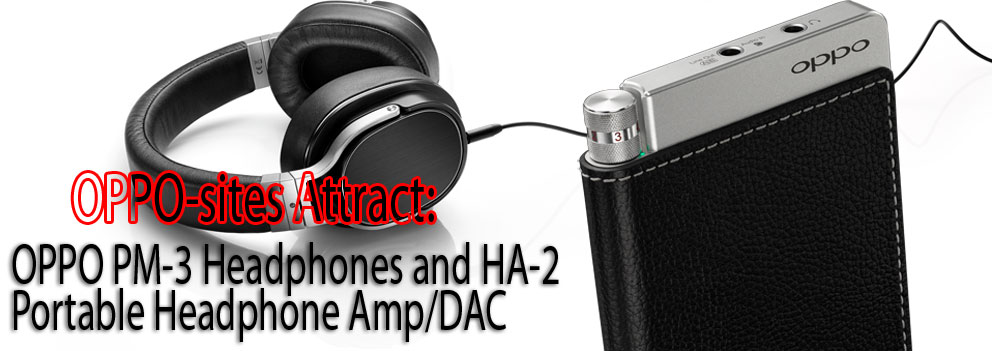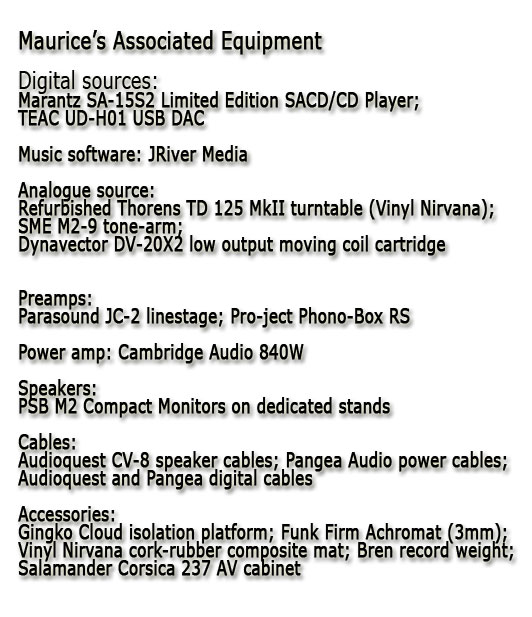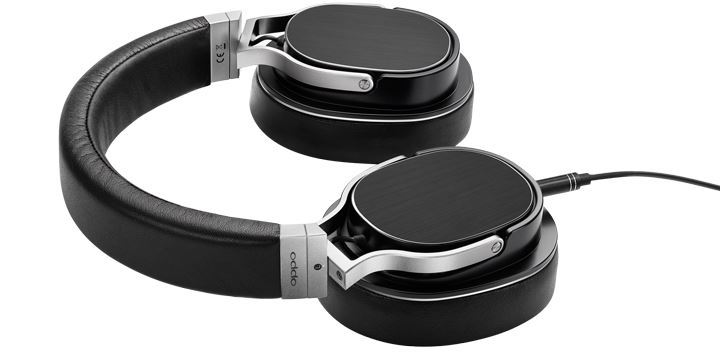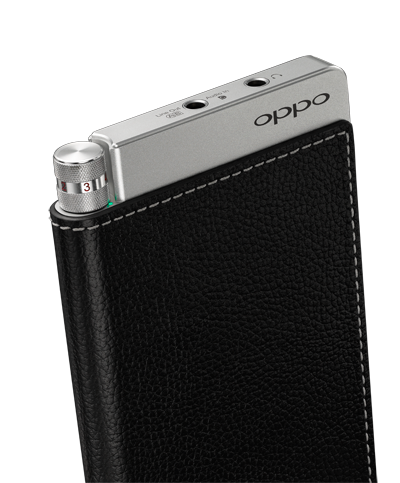OPPO PM-3 Headphones and HA-2 Portable Headphone Amp/DAC

Out with the old, in with the new
 At the outset, I need to issue an important disclaimer: I’m typically not a headphone sort-of-guy. Please don’t take this to mean that I dislike headphones or the headphone listening experience. Quite the contrary. I own and enjoy a pair of beloved Audio Technica ATH-AD700 headphones and a pair of Beyerdynamic DT 990 Premiums (the 600 Ohm model), transducers on opposite ends of the sonic spectrum. The ATs possess an almost Grado-like sweetness and warmth. They sound ever-so slightly soft up top, and simply gorgeous through the mids. The Beyerdynamics, at least to my ears, embody the analytical school of headphone design. They are superbly detailed and open, boast airy highs, but also lack a bit of tonal body, weight and bloom. I enjoy listening to both sets of headphones, but only occasionally.
At the outset, I need to issue an important disclaimer: I’m typically not a headphone sort-of-guy. Please don’t take this to mean that I dislike headphones or the headphone listening experience. Quite the contrary. I own and enjoy a pair of beloved Audio Technica ATH-AD700 headphones and a pair of Beyerdynamic DT 990 Premiums (the 600 Ohm model), transducers on opposite ends of the sonic spectrum. The ATs possess an almost Grado-like sweetness and warmth. They sound ever-so slightly soft up top, and simply gorgeous through the mids. The Beyerdynamics, at least to my ears, embody the analytical school of headphone design. They are superbly detailed and open, boast airy highs, but also lack a bit of tonal body, weight and bloom. I enjoy listening to both sets of headphones, but only occasionally.
 My current bedroom headphone system consists of a cobbled-together mix of newer and discontinued finds. A Dell Inspriron 17R PC running JRiver Media software streams hard-drive based content (stored on a 2TB Western Digital black box) to a Musical Fidelity USB-to-SPDIF converter and then to a stack of MF’s long-discontinued ‘X’ series silver boxes (a DAC/tube buffer/power supply combo). From there the signal runs into a long-discontinued PS Audio GCHA Headphone amp ($995 at retail) that I use to drive my headphones. This is about as far removed from the straight-wire-with-gain concept as one can imagine.
My current bedroom headphone system consists of a cobbled-together mix of newer and discontinued finds. A Dell Inspriron 17R PC running JRiver Media software streams hard-drive based content (stored on a 2TB Western Digital black box) to a Musical Fidelity USB-to-SPDIF converter and then to a stack of MF’s long-discontinued ‘X’ series silver boxes (a DAC/tube buffer/power supply combo). From there the signal runs into a long-discontinued PS Audio GCHA Headphone amp ($995 at retail) that I use to drive my headphones. This is about as far removed from the straight-wire-with-gain concept as one can imagine.
Sound quality and overall musical engagement levels are what one would expect: my little bedroom system certainly entertains when I’m in the mood for listening in the micro-verse, but little more. But consider this: when you add everything up – phones, the MF stack, JRiver’s sometimes quirky software, laptop, headphone amp, and cables – you get a system price that exceeded $4,000 at full retail. That’s a lot of dough to spend on a headphone system that delivers good but not great sound. Granted, I bought most of these components at deeply discounted close-out prices, but I still ended up shelling out well over $2,500 for the entire set-up. Like I said, not cheap.
Oppo Digital’s new PM-3 headphones and matching HA-2 portable headphone amp/DAC reveal just how much headphone listening has progressed (and improved) in recent years, and how much I’ve been missing. When linked to a $399 Wifi-enabled Apple iPad (my primary source for this review) streaming say, classical fare over BBC Radio 3 (free and broadcast in HD), the $299 HA-2 amp and $399 PM-3 headphones walk all over my current setup, and at a fraction of the cost ($1,100 vs. over $4,000 at full retail).
The PM-3 headphones offer notable improvements over my current reference phones in certain key areas, particularly in high end extension and air, transient quickness and overall macro-dynamic grunt, but strike me more as an evolutionary upgrade versus a complete upending of established paradigms (more on this later). The HA-2 amp/DAC on the other hand, redefines what one can expect from a compact, reasonably-priced headphone amp/DAC combo, at least in my limited experience, combining great industrial design, intuitive ergonomics and dazzling sound quality in an easy-to-use package. More importantly, when driven by my humble iPad, the Oppo duo made headphone listening not simply an entertaining diversion, but a moving, engaging experience.
Shiny new toys!

 Both Oppo products exude an attention to detail and overall sophistication that belie their modest asking prices. Superb ergonomics and ease-of-use round out each package. Beautifully machined metal joinery and supports give the PM-3s the look and feel of luxurious, pricier headphones. Like its tonier siblings – the PM-1/2 open-back models – the PM-3s employ a unique “7-layer double-side voice coil diaphragm design and FEM-optimized neodymium magnet system” that enabled Oppo to “reduce the weight of the planar magnetic drivers while maintaining excellent sound quality and high sensitivity.” The PM-3’s smaller 55 mm circular driver (versus the larger oval-shaped driver optimized for closed-back operation in the PM-1/2 phones) nevertheless boasts ease of drive and high sensitivity, bringing planar magnetic driver technology to a more accessible price point. An attractive leatherette finish – no, not the PM-1’s luxe lambskin wrap – brings the PM-3 price in at well under the $500 mark. (Please see Oppo’s superb website for additional design details).
Both Oppo products exude an attention to detail and overall sophistication that belie their modest asking prices. Superb ergonomics and ease-of-use round out each package. Beautifully machined metal joinery and supports give the PM-3s the look and feel of luxurious, pricier headphones. Like its tonier siblings – the PM-1/2 open-back models – the PM-3s employ a unique “7-layer double-side voice coil diaphragm design and FEM-optimized neodymium magnet system” that enabled Oppo to “reduce the weight of the planar magnetic drivers while maintaining excellent sound quality and high sensitivity.” The PM-3’s smaller 55 mm circular driver (versus the larger oval-shaped driver optimized for closed-back operation in the PM-1/2 phones) nevertheless boasts ease of drive and high sensitivity, bringing planar magnetic driver technology to a more accessible price point. An attractive leatherette finish – no, not the PM-1’s luxe lambskin wrap – brings the PM-3 price in at well under the $500 mark. (Please see Oppo’s superb website for additional design details).
The portable HA-2 headphone amp/DAC is no bigger than your average iPhone. It sports lovely beveled aluminum edges, solid casework and meticulous machining, all beautifully wrapped in a genuine leather case with contrast stitching. It feels as if hewn from a solid billet of aircraft grade aluminum. The HA-2 employs a hybrid class AB amplification circuit and a convenient asynchronous USB-DAC interface that allows the unit to receive digital audio inputs from any attached device. In my case this included the aforementioned Dell PC and an Apple ipad. The amp utilizes the superb ESS Sabre32 DAC which supports both 384 kHz PCM and DSD256 encoding and offers high-quality digital-to-analog conversion for a wide array of Apple-based devices, PCs and Mac computers. The amp operates on battery power and takes about an hour to charge fully when the battery runs down. I got about 6 or 7 hours of steady playback in-between charges. Even after two weeks of non-use, the HA-2 still retained about 75% of its playback power. Wow!
Sonic Impressions
I first plugged the PM-3s into my longtime reference headphone amp, the PS Audio GCHA. Source was the new and delightful Emotiva ERC-3 balanced CD player running via its balanced analogue outputs directly into the GCHA. It took only a few minutes to confirm that the PM-3’s and the GCHA were a match made in sonic hell. The system sounded awful. Textures sounded bleached, highs whitish and grainy, and a broad midrange trough (it literally sounded like a 6db drop) robbed voices, strings and woodwinds of their natural timbre and power. Voices in particular sounded hollow and overly reverberant. Obviously, and for reasons I can’t explain (other than a basic system mismatch), the PM-3s and the GCHA were totally incompatible devices.
Switching back to the HA-2 resulted in a wholesale sonic transformation. Vocals now sounded smooth, naturally-balanced, sweet and pure, if still a tad lean (but no longer hollow-sounding, bleached or chalky). Coupled to this purity and sweetness – especially for the price – was a remarkable level of transparency, lightning-quick transients, and a real sense of scale and drama.
Via the iPad, classical music of all sorts streamed from BBC Radio 3 sounded superb. In particular, the clarity and transparency of the presentation allowed specific tonal signatures – the blat of trumpets, the wail of saxophones, the rosiny bite of strings – and vital sound-staging cues to shine unimpeded. Densely scored orchestral works, from Strauss’s sublime tone poems to Jean Sibelius’s haunting Kalevala, were presented in all of their glory and with an impressive sense of performance hall size and scale.
 High def and standard “redbook” jazz downloads (played over iTunes or JRiver Media Center) streamed seamlessly from my laptop to the HA-2 in asynchronous mode and sounded just swell. Naturally miked recordings retained their sweetness and openness, with convincing transient attacks and lilting decays. Highs shimmered invitingly and midrange textures pulsated with life and energy. Plucked bass transients snapped with just the right amount of bounce, their meaty, creaky decays arguing without equivocation why acoustic stand up jobs trounce their electric counterparts in the musical realism department. Danish jazz sensation Sinne Eeg sounded every bit her airy, effervescent self. The Oppo duo captured her impeccable sense of timing and superb phrasing completely in-tune and wholly intact rhythmically. Whether lilting and provocative on “Crowded Heart” or, by turns lyrical and unrequited on Legrand and Bergman’s plaintive “What Are You Doing for the Rest of Your Life” (both from Face the Music [Stunt Records – STUCD 14042]), the HA-2/PM-3 combo captured the music’s shifting gestalt in a totally convincing fashion.
High def and standard “redbook” jazz downloads (played over iTunes or JRiver Media Center) streamed seamlessly from my laptop to the HA-2 in asynchronous mode and sounded just swell. Naturally miked recordings retained their sweetness and openness, with convincing transient attacks and lilting decays. Highs shimmered invitingly and midrange textures pulsated with life and energy. Plucked bass transients snapped with just the right amount of bounce, their meaty, creaky decays arguing without equivocation why acoustic stand up jobs trounce their electric counterparts in the musical realism department. Danish jazz sensation Sinne Eeg sounded every bit her airy, effervescent self. The Oppo duo captured her impeccable sense of timing and superb phrasing completely in-tune and wholly intact rhythmically. Whether lilting and provocative on “Crowded Heart” or, by turns lyrical and unrequited on Legrand and Bergman’s plaintive “What Are You Doing for the Rest of Your Life” (both from Face the Music [Stunt Records – STUCD 14042]), the HA-2/PM-3 combo captured the music’s shifting gestalt in a totally convincing fashion.
Importantly, the sound quality improvements I heard with the HA-2 driving the Oppo phones (versus the Franken-stack) were replicated to a large degree when I replaced the 3s with both the ATH-AD700 and DT 990 Premium models.
Downsides
Thus far, all that glitters has been gold, or at least gold-plated. However, a couple of chinks in the HA-2/PM-3 armor emerged upon extended listening. When pushed dynamically, the sound predictably hardened and thinned. I couldn’t tell whether this was a case of amp clipping or my reaching the excursion limits of the planar magnetic drivers (probably a bit of both), but push the amp and phones too hard and they will respond with bright, harsh sound. But at sane listening levels, I never reached this unpleasant threshold.
Second, the Oppo duo does not treat bright, poorly recorded works kindly. They adhere to the open and revealing school of design, the phones in particular, so they may not appeal to listeners seeking a warmer, plusher headphone experience. As such, the upward tilt engineered into all-too-many modern classical recordings and most compressed popular works sound like, well, like bright and compressed garbage respectively. Feed them a steady diet of naturally balanced recordings, however, and the HA-2/PM-3 combo rewards with balanced, natural sound. This isn’t a criticism as such but reflects what I think is the chosen Oppo house sound: pepper-minty and airy versus warm and relaxed. Although I tend to prefer a somewhat richer overall tonal balance, I found their light, athletic, rhythmically propulsive presentation highly addicting and enjoyable.
Lastly, the PM-3s are not the most comfortable transducers around. They always felt a touch tight and constraining on my admittedly big head. A brief perusal of the internet indicates that I am not the only reviewer to notice this. To put this into context, the PM-3s never caused me any pain or gross discomfort and I could listen to them for hours on end without much protest. But I was always aware of their presence on my head (and around my ears).
Conclusion
So there you have it, micro-verse maniacs. The Oppo HA-2/PM-3 combo offers superb build quality, excellent ergonomics and great sound at a bargain price. The PM-3’s closed-back architecture does a great job blocking external noise, and the HA-2 amp prodded every phone in my house (an admittedly small lineup) to deliver its best. Warmly recommended then, with the noted caveats.
Good listening!


Product specs
OPPO HA-2 Headphone Amp/DAC
● ESS Sabre32 Reference ES9018-K2M
● 32/384 PCM, DSD256 conversion
● asynchronous USB connectivity
● Two gain settings (high and low)
● Maximum output: 300 mW (into 16 Ohms)
● Frequency range: 20 Hz – 200kHz
● Headphone Output Impedance: 0.5 Ohms
● Output Jacks: 3.5mm (1/8″) stereo
● USB and USB micro input jacks
● Bass boost switch
● Battery: 3,000 mAh
● Dimensions: 0.5″ H x 2.7″ W x 6.2″ D
● Weight: 6.2 oz.
Price: $399.00
Headphone Specifications
Acoustic Principle: Closed back
Ear Coupling: Circumaural
Nominal Impedance: 26 Ohm
Sensitivity:102 dB in 1 mW
Clamping Pressure: 5 N
Cables: 3 m detachable cable (3.5 mm with 6.35 mm adapter)
1.2 m detachable cable (3.5 mm)
Cable Connectors: Output: 3.5 mm stereo jack
Input: 6.35 mm stereo jack, 3.5 mm stereo jack
Weight: 320 g (without cable)
Included AccessoriesCarrying Case
User Manual
Driver Specifications
Driver Type: Planar Magnetic
Driver Size (Round):55 mm diameter
Magnet SystemSymmetric push-pull neodymium
Frequency Response: In Free-Field: 10 – 50,000 Hz
Long-Term Max Input Power: 500 mW according to IEC 60268-7
Pulse Max Input Power: 2 W
Price: $399.00
Manufacturer information
OPPO Digital
Phone: (650) 961-1118
Website: www.oppodigital.com
Stereo Times Masthead
Publisher/Founder
Clement Perry
Editor
Dave Thomas
Senior Editors
Frank Alles, Mike Girardi, Russell Lichter, Terry London, Moreno Mitchell, Paul Szabady, Bill Wells, Mike Wright, and Stephen Yan,
Current Contributors
David Abramson, Tim Barrall, Dave Allison, Ron Cook, Lewis Dardick, John Hoffman, Dan Secula, Don Shaulis, Greg Simmons, Eric Teh, Greg Voth, Richard Willie, Ed Van Winkle, Rob Dockery, Richard Doran, and Daveed Turek
Site Management Clement Perry
Ad Designer: Martin Perry






Be the first to comment on: OPPO PM-3 Headphones and HA-2 Portable Headphone Amp/DAC